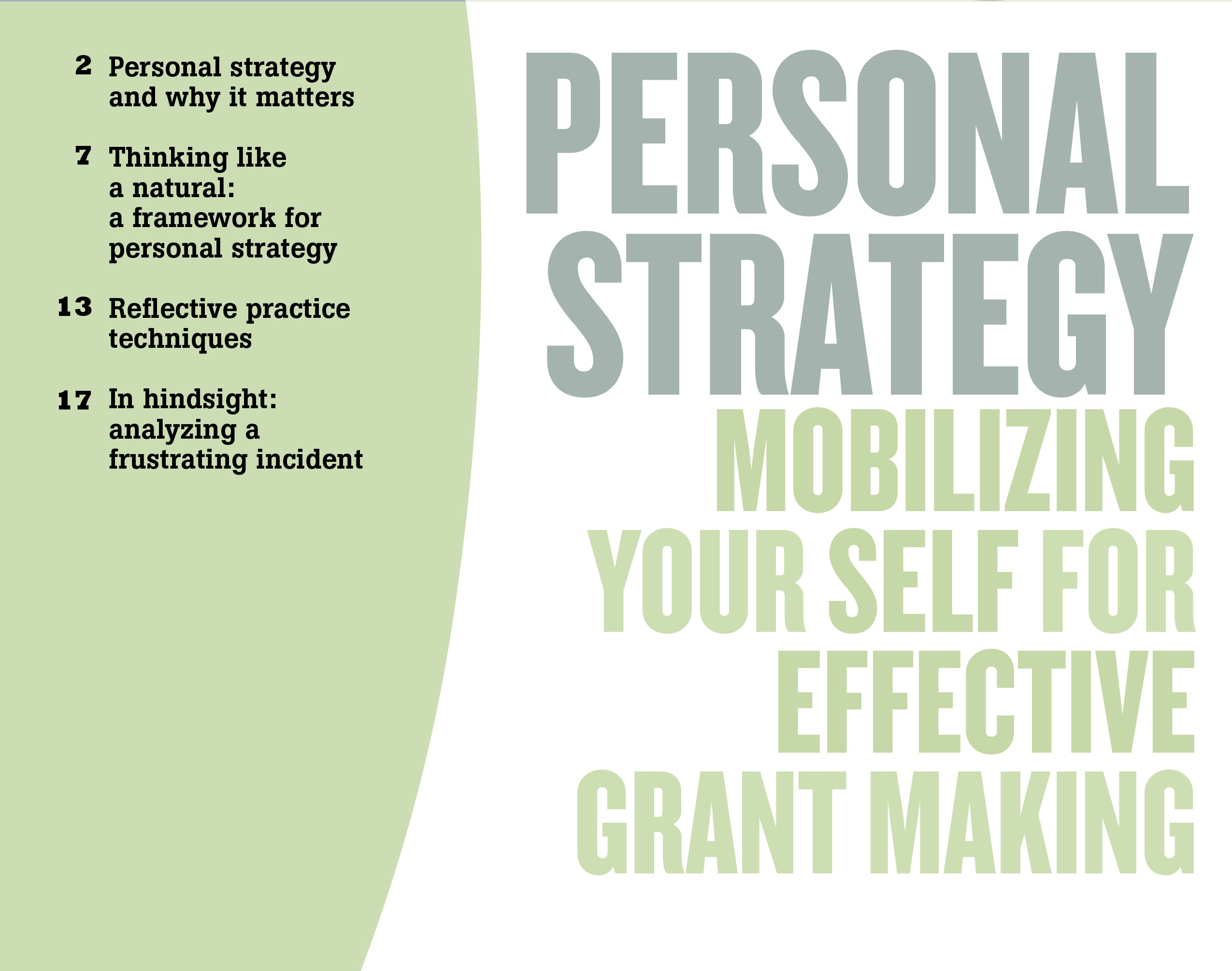Personal Strategy Discussion Guide for Thoughtful Funder Reflection
These questions pertain to GrantCraft's guide, Personal Strategy: Mobilizing Yourself for Effective Grantmaking. Read the guide independently. Then, together with colleagues, discuss the following questions:
The organizational theorist Donald Schön named the ambiguous situations that exist in fields of practice the “swampy lowlands.”
- What swampy lowlands have you encountered in your work as a funder?
- How did you handle the situation?
- If you could do it over, what would you do differently?
Consider a time when you conducted a difficult conversation with a grantee; presented a risky proposal to your board; or gave critical feedback to a grantseeker.
- What worked?
- What didn’t work?
This GrantCraft guide defines “role” as a set of broadly defined expectations that come with the job and the discretion grantmakers are given to meet them.
- Does your organization have a set of expectations about your role as a grantmaker?
- If yes, are they explicit or implicit? What are these expectations?
- If not, have you established expectations for yourself and your team? What are these expectations?
- How do you know if you and your colleagues are meeting them?
Let’s build on this to reflect upon a trio of concepts—role, self, and system—that help analyze personal strengths and weaknesses and consider the larger environment in which the grant maker hopes to be effective.
Role
Organizational theorist and consultant Larry Hirschhorn writes about “the large zone of discretion” in which “you have to decide how to execute your work.”
- Do you feel you have the amount of discretion needed to execute your work effectively?
- How have you taken advantage of this flexibility?
- How might you codify examples of good practice that can be adapted by yourself and others?
Self
One way of thinking about organizational strategy is to ask “what should we do to advance our mission… in light of our own strengths and weaknesses?”
- What strengths—such as skills, life experience, personality traits, and passions—do you bring to your work as a funder?
- What weaknesses—such as insecurities, blind spots, knowledge gaps, and personal quirks—complicate matters?
System
How do other roles (boss, board, grantseeker, grantee, colleague) create distinctive conditions around your place in the work system? In other words, does the observation that much of what goes on in the workplace is not the product of person-to-person interactions, but person-in-role to person-in-role interactions ring true?
Educator and consultant Barry Oshry has shown how people’s position in a work system—as a “top,” “middle” or “bottom”—affects their behavior and performance. As middles, grantmakers may feel pulled from both sides leading to an overalignment with one side or another. Or by becoming bureaucratic as a way to reduce dissonance and keep people away. Or by trying to please everyone and perhaps coming across to all as weak.
- Can you think of situations you responded in any of these ways?
- What did you learn?
- How can you help people make things happen in the world?
- What can you do to maintain your independence of thought and action?
Personal Strategy Framework
The power of an analytic framework is that it provides a way to understand explicitly things we already do but don’t usually reflect upon.
Share examples of situations where you behaved as a:
- Bureaucrat (high role-awareness, low self-awareness)
- Bystander (low role-awareness, low self-awareness)
- Personalizer (low role-awareness, high self-awareness)
- Natural (high role-awareness, high self-awareness)

Reflective Practice Techniques
1. Analyze your frustrating incidents.Choose an incident when you were not satisfied with the outcome and, even with the benefit of hindsight, are not sure how you should have proceeded. Recall what you were trying to accomplish, how you went about it, and what was frustrating. Try to identify a turning point where you could have responded differently.
- What quadrant were you operating from?
- How did you see your role?
- How did you bring yourself to the role?
- What strengths might have helped?
- What weaknesses should you have guarded against?
Consider keeping an occasional journal of incidents for yourself or—working with colleagues—consider building up a “library” of incidents for your organization that can be especially useful for training new employees.
2. Create dialogue around your role.
Start to uncover the implicit mental images you have of a grantmaker’s role. Complete and compare simple analogies:
- “grantmaker is to grantee” as _________ is to _________
- “grantmaker is to our foundation” as _________ is to __________
3. Reverse-engineer your role models.
Name one of your work role models.
- How does his or her natural strengths and weaknesses align with yours?
- Are you bringing someone else’s self instead of your own to your role?
4. Mobilize yourself, not your self-image.
- Identify two desired images you bring to work situations. Identify two behaviors you typically engage in to advance each image.
- Identify two dreaded images you bring to work situations. Identify two behaviors you typically engage in to deflect each image.
5. Plot your partner.
- See if you can extend the personal strategy framework to an awareness of where your partner is in a given interaction.
- When you analyze a frustrating incident, identify whether your partner was using a bureaucratic, bystander, or personalizer approach and what you might have done to help them become a natural.


